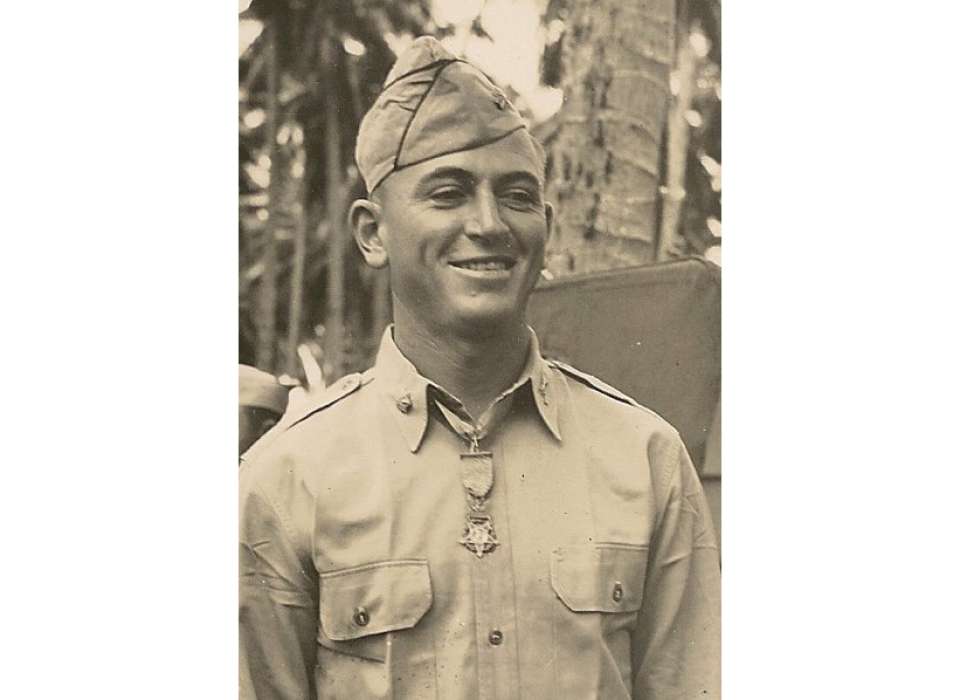Top image: Charles Willis Davis wearing his Medal of Honor. Photo and action citation courtesy of the Congressional Medal of Honor Society.
World War II ripped millions of men and women from their homes and hurled them around the globe. Americans like Charles Willis Davis discovered, though, under the most extreme circumstances, that they possessed incredible courage and ability.
Born in the small town of Gordo in west-central Alabama in February 1917, Davis exhibited great athleticism in high school before going to the University of Alabama. In college he was the baseball team’s pitcher while preparing for a career as an attorney. After completing a year of law school, Davis was commissioned as a 2nd Lieutenant in the Infantry through the US Army’s ROTC program.
Sent to Fort Benning, Georgia, to undergo infantry training, Davis was then transferred to Fort Sam Houston, Texas. At Fort Sam Houston, 2nd Lieutenant Davis fell in love with and married Joan Kirk in June 1941. War would soon profoundly reshape the lives of Charles and Joan.
Ordered to Schofield Barracks on Oahu, Hawaii, Davis joined the recently activated 25th Infantry Division. Joan was expecting their first child when world history intervened on Sunday, December 7, 1941. During the Japanese attack, Charles manned a defensive position on the perimeter of Schofield Barracks. Shaken by the sound and fury of the Japanese assault, Joan ran outside of the barracks, and was forced to take cover. Evacuated, Joan gave birth to a daughter, Carol, the very next day, just as news of the US declaration of war against Japan reached her and Charles.
Eleven months later, Davis departed Hawaii and said goodbye to Joan and Carol. As Executive Officer, 2nd Battalion, 27th Infantry Regiment, 25th Infantry Division, under the command of Brigadier General Joseph Lawton “Lightning Joe” Collins, he headed to Guadalcanal in the Solomon Islands.
Between late November and early January, the 25th Infantry Division arrived on Guadalcanal. Landing on December 17, he and the soldiers immediately relieved men of the 1st and 2nd Marine Divisions in protecting Henderson Field, the much-coveted airstrip.
Brigadier General Collins passed on to his men in early January orders from General Alexander Patch, commander of XIV Corps, of which the 25th was a part. The 27th Regiment, Davis’s unit, was directed to seize a ridge line named “Galloping Horse,” one of three American objectives all near the Matanikau River, in the northwestern part of Guadalcanal.
With the attack launched on January 10, 1943, the ensuing combat was harrowing. A young lieutenant, severely wounded by a Japanese mortar round, died in Davis’s arms. But it was on January 12 and 13 that Davis distinguished himself and won a place in history. Davis’s Medal of Honor Citation records, unforgettably, what he did on that day on Guadalcanal:
“For distinguishing himself conspicuously by gallantry and intrepidity at the risk of his life above and beyond the call of duty in action with the enemy on Guadalcanal Island. On 12 January 1943, Maj. Davis (then Capt.), executive officer of an infantry battalion, volunteered to carry instructions to the leading companies of his battalion which had been caught in crossfire from Japanese machine guns. With complete disregard for his own safety, he made his way to the trapped units, delivered the instructions, supervised their execution, and remained overnight in this exposed position. On the following day, Maj. Davis again volunteered to lead an assault on the Japanese position which was holding up the advance. When his rifle jammed at its first shot, he drew his pistol and, waving his men on, led the assault over the top of the hill. Electrified by this action, another body of soldiers followed and seized the hill. The capture of this position broke Japanese resistance and the battalion was then able to proceed and secure the corps’ objective. The courage and leadership displayed by Maj. Davis inspired the entire battalion and unquestionably led to the success of its attack.”
Following his heroics on Guadalcanal, Davis was promoted to Major. On July 17, 1943, he received the Congressional Medal of Honor.
Jason Dawsey, PhD
Jason Dawsey, PhD, is ASU WWII Studies Consultant in the Jenny Craig Institute for the Study of War and Democracy.
Cite this article:
MLA Citation:
APA Citation:
Chicago Style Citation:







![Max Fuchs, New York City cantor, sings as Rabbi Sydney [sic] Lefkowitz, Richmond, VA, conducts the first Jewish services from Germany.](/sites/default/files/styles/max_650x650/public/2025-10/image1.jpg)

